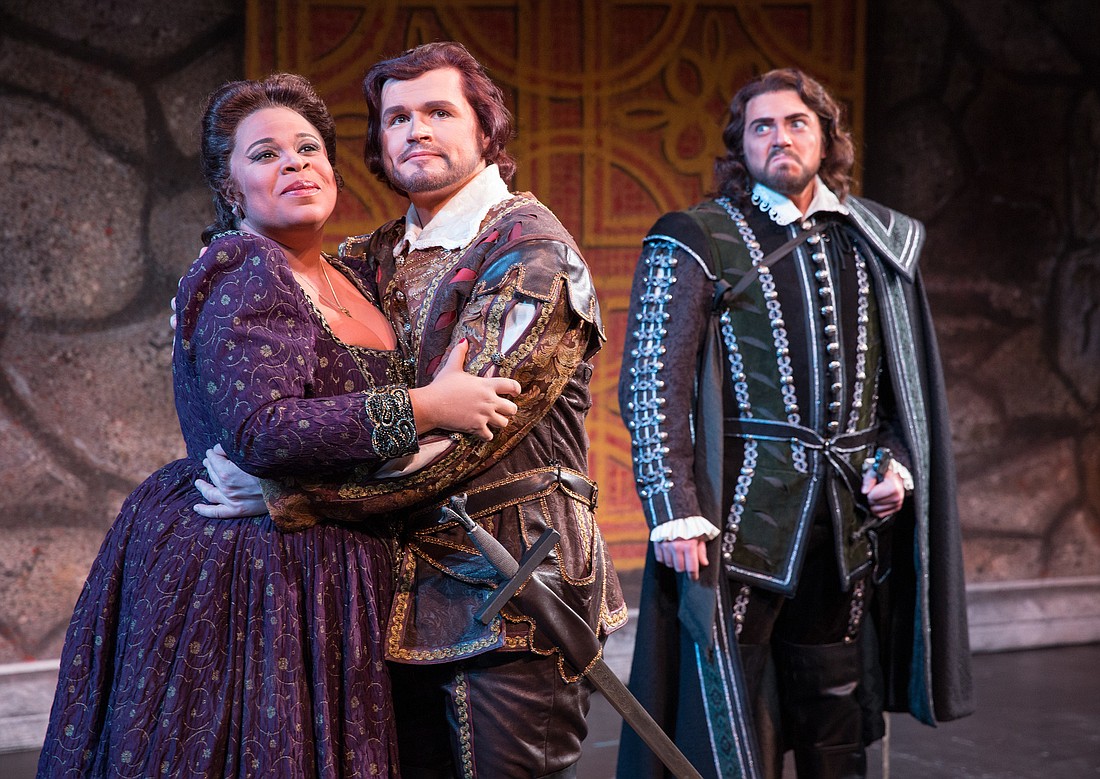- April 19, 2024
-
-
Loading

Loading

To quote Sarasota Opera’s program notes about Verdi’s “Il Trovatore,” “Argument raged about the opera’s worth.” They say there was a minority “who found the story absurd, the tunes vulgar and the orchestration too noisy.” Now, almost a century and a half later, some of us still find the story absurd but, oh, the music.
The story? That’s another story.
In a nutshell, “Il Trovatore” is a tale of mistaken identity and revenge. Azucena, a gypsy woman whose mother was burned at the stake on order of the Count, kidnaps the Count’s son and, in a frenzy, mistakenly throws her own child into the fire instead of the Count’s. (This, of course, is something we can all relate to, having had, at one time or another, one of those hissy fits ourselves.) The story proceeds, disjointedly, scene by scene, act by act, unfolding the lives of the Count, who’s in love with Leonora, who’s in love with Manrico, the now-grown man who thinks he’s Azucena’s son (but really isn’t). Jealousy abounds. Hatred spurs wars. The Count thinks he killed Manrico but Manrico is not dead. Manrico is captured by the Count, who wants to rekill him, for good this time. And Azucena, also imprisoned, is about to follow in her mother’s footsteps to the stake. Leonora makes a deal with the Count.
“Take me but let Manrico go free,” she says.
But, before the Count can claim her, she takes poison and dies. The Count, in another rage, sends Manrico to his death (off stage) and, as the Count triumphantly tells Azucena Manrico is really dead this time, the gypsy turns and breaks the news that Manrico and the Count are really brothers and he just committed fratricide.
This tale is unfolded through some of the most glorious, tune-filled music Verdi gave us, so, for three or so hours, we are able to suspend our sense of reality and allow ourselves to be enveloped in sheer sound.
Sarasota Opera is one of the few important companies in the country that delivers opera the way the composer envisioned it when it was first written. How do we know what Verdi wanted? Victor DeRenzi, the company’s artistic director and conductor, is a Verdi scholar and he’s gone back in time, figuratively speaking, to unearth original concepts, stagings, costumes, scenery and style. If you want to see and hear an opera as the composer intended it at the time he wrote it, Sarasota Opera is the place to be.
As a result, the Sarasota Opera’s opening of “Il Trovatore” was stylistically right on the money. Leading the Sarasota Opera Orchestra, DeRenzi brought clean, controlled and beautifully Verdian sounds from the instrumentalists, offering solid support to the singers while never sagging the tempos or pushing the phrases. (The fact that we have two orchestras of such excellence in town at the same time never fails to boggle my mind.)
Michael Schweikardt’s scenery was perfectly appropriate for the time; it took us into stony castles and dank dungeons with just the right density and dust. Ken Yunker’s lighting captured the right time of day — mostly nighttime — with enough darkness to be somber and enough light in the right places to illumine the characters. And Howard Tsvi Kaplan’s costumes carried the look and weight of the period.
Even Director Peter Sellars, who set Mozart’s “Cosi fan tutte” in a diner, “Marriage of Figaro” in Trump Tower and “Don Giovanni” in Spanish Harlem, would be hard-pressed to update or renovate “Il Trovatore.” Stage Director Stephanie Sundine stuck to tradition and, in doing so, gave us a taste of true 19th century grand opera, while still allowing the singers a modicum of freedom to express their characters without upstaging Verdi’s stunning music.
The men in this cast were, vocally, somewhat superior to the women. Jeffrey Beruan set the tone of the evening with a stalwartly acted, well-sung Ferrando, giving us the background of the past 15 years with bravura singing from the chorus. In fact, the ensemble singing and clanging in the famous “Anvil Chorus” was so overwhelming in sound, I was almost pushing into the back of my seat. David Pershall, making his Sarasota Opera debut as the Count de Luna, was regal and vocally resplendent, vacillating (as Verdi intended) among emotions, from jealousy to love to murder, with the ease of the royal pawn he was fated to be. And, although Kirk Dougherty brought the role of Manrico a smaller voice than usually associated with this difficult part, he also showed a knack for spinning long phrases that almost took our breath away. His “Di quella pira,” while small in sound, was strong in intensity.
Both Reyna Carguill as Leonora and Margaret Mezzacappa as Azucena have wide vibratos, verging on flutters. Mezzacappa was the more believable character because the depth and power of her low tones brought a profundity to Azucena’s music, from her opening, “Stride la vampa,” to her final declamation and coup de grace to the Count. Carguill’s Leonora lacked the vocal nuance and floating tones we’ve come to associate with her character’s avalanche of arias toward the end of the opera but, again, the music — which steeps us in one beautiful melody after another — stole the show. The soprano certainly has all the notes and had no trouble singing them, but she lacked emotional subtlety.
Studio Artists Tania Maria Rodriguez and Thorstein Arbjornsson, and Apprentices Blake Hudson and Jared Esguerra sung smaller roles.
This is an exhausting and exhaustive experience of “Il Trovatore,” but when it comes to grand opera, nothing can beat Sarasota Opera in authentic grandeur.